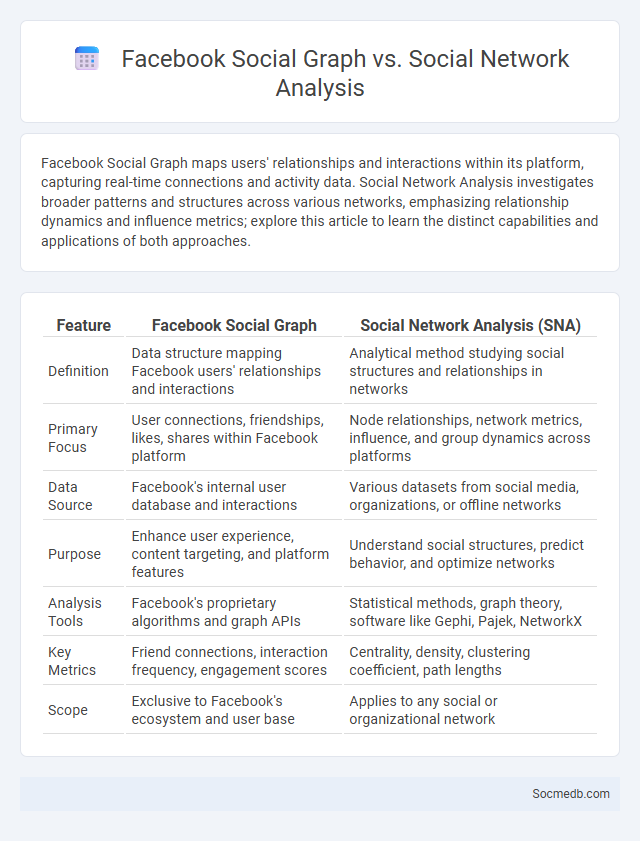
Photo illustration: Facebook Social Graph vs Social Network Analysis
Facebook Social Graph maps users' relationships and interactions within its platform, capturing real-time connections and activity data. Social Network Analysis investigates broader patterns and structures across various networks, emphasizing relationship dynamics and influence metrics; explore this article to learn the distinct capabilities and applications of both approaches.
Table of Comparison
| Feature | Facebook Social Graph | Social Network Analysis (SNA) |
|---|---|---|
| Definition | Data structure mapping Facebook users' relationships and interactions | Analytical method studying social structures and relationships in networks |
| Primary Focus | User connections, friendships, likes, shares within Facebook platform | Node relationships, network metrics, influence, and group dynamics across platforms |
| Data Source | Facebook's internal user database and interactions | Various datasets from social media, organizations, or offline networks |
| Purpose | Enhance user experience, content targeting, and platform features | Understand social structures, predict behavior, and optimize networks |
| Analysis Tools | Facebook's proprietary algorithms and graph APIs | Statistical methods, graph theory, software like Gephi, Pajek, NetworkX |
| Key Metrics | Friend connections, interaction frequency, engagement scores | Centrality, density, clustering coefficient, path lengths |
| Scope | Exclusive to Facebook's ecosystem and user base | Applies to any social or organizational network |
Understanding Facebook’s Social Graph
Facebook's Social Graph maps the connections between people, pages, and interests, creating a dynamic network that reflects real-world relationships. Your interactions, friendships, and shared content shape this extensive web, enabling personalized experiences and targeted content delivery. Understanding the Social Graph helps you leverage Facebook's algorithms for enhanced engagement and meaningful social connections.
Fundamentals of Social Network Analysis
Social Network Analysis (SNA) studies relationships and interactions within social structures using graph theory, where nodes represent individuals or entities and edges represent connections or interactions. Key metrics such as centrality, density, and clustering coefficients quantify influence, connectivity, and community structure within networks. SNA helps identify influential actors, information flow patterns, and the overall topology of social media platforms, enhancing targeted marketing and communication strategies.
What Is a Social Graph?
A social graph represents the network of relationships and interactions among individuals on social media platforms, mapping connections like friendships, followers, and shared interests. It helps visualize how users, including You, are linked, enabling platforms to tailor content, recommend connections, and improve user engagement. Understanding your social graph enhances the way social media algorithms deliver relevant information and foster community building.
Key Differences: Facebook Social Graph vs Social Network Analysis
Facebook Social Graph represents the explicit connections and interactions between users, pages, and content within the Facebook ecosystem, emphasizing real-time social relationships and user-generated data. Social Network Analysis (SNA) is a broader analytical framework that studies relationships and structures in any network by applying metrics like centrality, density, and clustering to uncover hidden patterns and influence beyond explicit connections. While Facebook's Social Graph is a practical application of social data within a specific platform, SNA provides theoretical tools and methodologies to analyze social systems across multiple contexts and platforms.
Applications of Facebook’s Social Graph
Facebook's Social Graph enables personalized experiences by mapping relationships and interactions between users, pages, and content. You can benefit from advanced algorithms that recommend friends, groups, and events based on these connections, enhancing engagement and relevance. This technology facilitates targeted advertising and community building, driving social networking efficiency and user satisfaction.
Techniques Used in Social Network Analysis
Techniques used in social network analysis include graph theory, which models relationships as nodes and edges to reveal network structure and key influencers. Centrality measures such as degree, betweenness, and closeness identify influential users and information flow within social media platforms. Community detection algorithms group users into clusters based on interaction patterns, enabling targeted marketing and behavioral insights.
Social Graph Beyond Facebook
The social graph extends far beyond Facebook, encompassing intricate connections across platforms like Twitter, LinkedIn, Instagram, and emerging networks. It maps relationships, interactions, and shared interests, enabling personalized content delivery and targeted advertising that enhances Your digital experience. Understanding this dynamic web is crucial for leveraging social media's full potential in networking, marketing, and influence building.
Data Privacy and Ethical Considerations
Social media platforms collect vast amounts of personal data, making data privacy a critical concern for users and regulators alike. Ethical considerations include transparent data handling practices, informed user consent, and preventing misuse such as surveillance or targeted misinformation. Ensuring compliance with regulations like GDPR and promoting user education on privacy rights are essential for building trust in digital communities.
Future Trends in Social Relationships Mapping
Future trends in social relationships mapping will leverage artificial intelligence and machine learning to analyze complex interaction patterns across platforms like Facebook, Instagram, and LinkedIn. These advancements will enable your ability to identify influential connections, emerging communities, and shifts in social dynamics with greater precision. Real-time sentiment analysis and behavioral prediction will transform how social networks understand and optimize relationships for personalized user experiences.
Choosing the Right Tool: Social Graph or Social Network Analysis
Choosing the right tool between Social Graph and Social Network Analysis depends on the specific goals of social media strategy. Social Graph focuses on visualizing relationships and connections among users to identify key influencers, while Social Network Analysis employs quantitative techniques to measure network structures and dynamics, enhancing targeted marketing efforts. Leveraging Social Network Analysis empowers brands to optimize content distribution and engagement by understanding user behavior patterns and community clusters.
 socmedb.com
socmedb.com